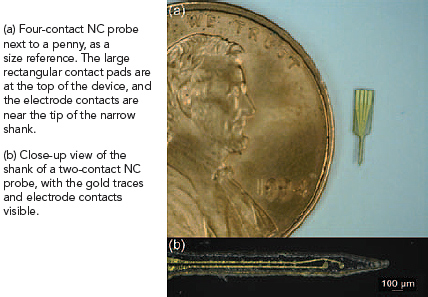Advanced Platform Technology Center
Dynamic Intracortical Probes
Interfacing to the cerebral cortex requires cortical probes to be stiff for insertion, but flexible chronically to avoid repeated trauma and potential damage to the brain. Investigators with the APT Center have developed such an intracortical microprobe based on a bio-inspired, mechanically- adaptive polymer nanocomposite (NC) for brain-machine interface applications. The NC is stiff when dry and becomes more flexible as cerebral spinal fluid permeates it after implant. This probe is designed to be used to study the relationship between implant mechanics, the neuroinflammatory response, and the long-term quality and reliability of neural recordings. The overall goal is to systematically identify the optimal neural probe design and materials for long-term neural recording reliability.
The process for fabricating NC-based neural microprobes with up to four electrode recording sites on a single device has been developed that combines laser-micromachining, thin-film deposition, photolithography, and wet and dry etching steps. Preliminary bench and in vivo evaluations of the probes are encouraging, with no evidence of delamination after accelerated soak tests and documented ability to record unit spikes during acute animal experiments.

Principal Investigators: Jeffrey Capadona, Ph.D. • Allison Hess-Dunning, Ph.D. • Dustin Tyler, Ph.D.
Funding Agency: National Institutes of Health




















